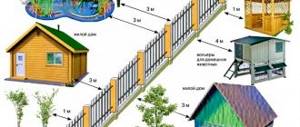Types of land ownership rights
The list of documents, both establishing and confirming title, depends on the type of ownership
You can own land in Russia, taking into account the regulations of the law, on the basis of the following types of rights:
- Easement is the right to own someone else's land in a limited way for the performance of certain actions. For example, to enter your own site, use communications, ensure trouble-free operation of construction equipment;
- public easement – established at the state level without extraction from the property of citizens. In order to ensure the ability to perform certain nationally important actions;
- gratuitous use - the right is transferred to the owner of the land for a certain period;
- permanent exploitation – provided by the local government as the owner of the land in accordance with regulations;
- lifelong inheritable right - transferred on the basis of a will or deed of gift;
- ownership ensures complete disposal of the object - its operation, donation, by will, development and other actions.
Ownership rights arise in the process of acquiring land, receiving it as a gift or by inheritance.
Information on land plots contained in the State Real Estate Cadastre
- 1) boundaries of cadastral division units;
- 2) state border of the Russian Federation;
- 3) borders between constituent entities of the Russian Federation;
- 4) boundaries of municipalities;
- 5) boundaries of settlements;
- 6) boundaries of zones with special conditions for the use of territories;
- 7) boundaries of land plots;
 contours of buildings, structures, unfinished construction objects on land plots;
contours of buildings, structures, unfinished construction objects on land plots;- 9) numbers of cadastral division units;
- 10) cadastral numbers of land plots, buildings, structures;
- 11) types of real estate (land plots, buildings, structures, unfinished construction objects).
We recommend reading: What is the scholarship for?
cadastral maps of the territories of the constituent entities of the Russian Federation, representing a set of cadastral maps of the territories of municipalities located within the borders of the relevant constituent entities of the Russian Federation, and intended for use by executive authorities of the constituent entities of the Russian Federation.
Lecture 10
The system of cadastral division of the territory of the Russian Federation is designed to ensure the assignment of cadastral numbers to land plots in accordance with their location. Therefore, when developing a project, it is necessary to pay special attention to the use of terrain elements (bases of cadastral division) that are clearly understood and reflected on planning materials to describe the boundaries of cadastral blocks. Such terrain elements should include large natural linear objects (living tracts), clearings in the forest, as well as linear objects created by human labor that have a continuous right-of-way (railways and highways, ground pipelines, etc.). The elements used include the boundaries of settlements (fixed on the ground), as well as streets, public passages and other objects that are the planning basis of the built-up area. As bases, you can also use objects under construction, the construction of which is at the stage of completion or for the construction of which land plots have been allocated in the prescribed manner.
Changing the boundaries of a land plot
- In case of cadastral error. Then the geodetic company that made a similar error in the documentation carries out the land surveying work again and draws up a new cadastral plan with changed land boundaries.
- At the initiative of the owner. When one plot is divided into several, as well as when two or more plots are combined into one. And in this case, it will be necessary to carry out boundary work again.
- When clarifying the boundaries of the land plot. The owner resorts to the procedure for changing the boundaries of a plot of land if, when clarifying the boundaries, it turns out that the actual area of the plot differs significantly from that indicated in the documents. To avoid having to register a change in the boundaries of the site, the deviation in area cannot be more than 10%. If this indicator is exceeded, the owner has no choice but to change the boundaries of the land plot.
In other words, this is a partial change in the location of the plot, when one of the owners expands the boundaries of his plot, while the neighboring plot moves exactly the same distance in order to keep its area unchanged. Based on the results of the shift, each of the newly formed areas will be assigned new cadastral numbers.
We recommend reading: How much does a notary charge for drawing up a deed of gift?
Validity periods of documents for a land plot
There is no validity period for title and title documents. All contracts and certificates are issued for an indefinite period.
Replacement of documents is required only if they were previously lost or damaged.
To do this, you need to contact the general register, draw up a written application and pay a state fee of 200 rubles (for one copy). The validity period can only change for a rent agreement, a social tenancy agreement, a certificate of the right to perpetual use of land, as well as when alienating a land plot, when registering an inheritance agreement or a gift transaction.
Title and title documents are important papers that are necessary both for carrying out various manipulations with a land plot and for free use of personal territory. Thanks to such documents, you are the legal owner of your land, which means that the owner has the right to sell, lease or develop the territory with any objects, as well as conduct economic, rural, dacha, gardening or farming activities.
GOALS AND OBJECTIVES OF THE CADASTRE DIVISION OF THE TERRITORY
1. Identified errors in the selection of cadastral division bases and their description. For example, establishing the boundaries of a cadastral division along the right of way of a highway or the red line of a street. In this case, it is not possible to assign numbers to land plots on the boundaries of blocks without an accurate description of their location in the coordinate system adopted for the right of way or red line.
When establishing the cadastral number of a block in a populated area and in an inter-settlement area, options are possible when using the levels (components) of the cadastral number of the base cadastral block. In the inter-settlement area there are fewer land plots than in the populated area. Therefore, for inter-settlement areas it is sufficient to use only the array-block levels. Settlements are united into village administrations, which are usually identified by block number. In settlements, it is necessary to use three levels: block-array-quarter, otherwise it will be impossible to assign cadastral numbers to land plots in settlements.
Land law
In relation to plots acquired by individuals and legal entities under the terms of housing construction on them, with the exception of individual housing construction, the tax amount is calculated taking into account coefficient 2 during the three-year period of design and construction until the state registration of rights to the constructed property.
We recommend reading: Returning goods from an individual entrepreneur







